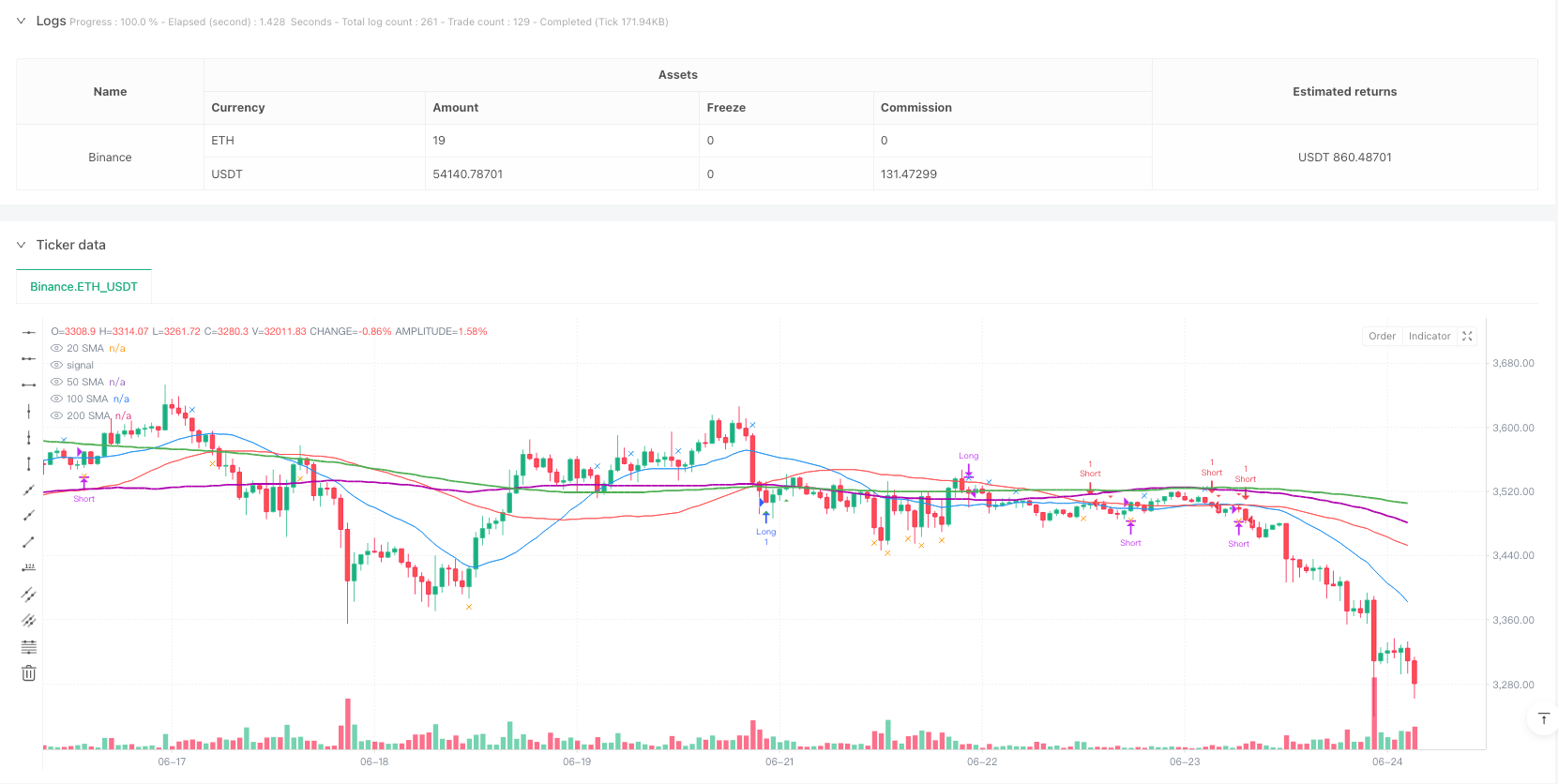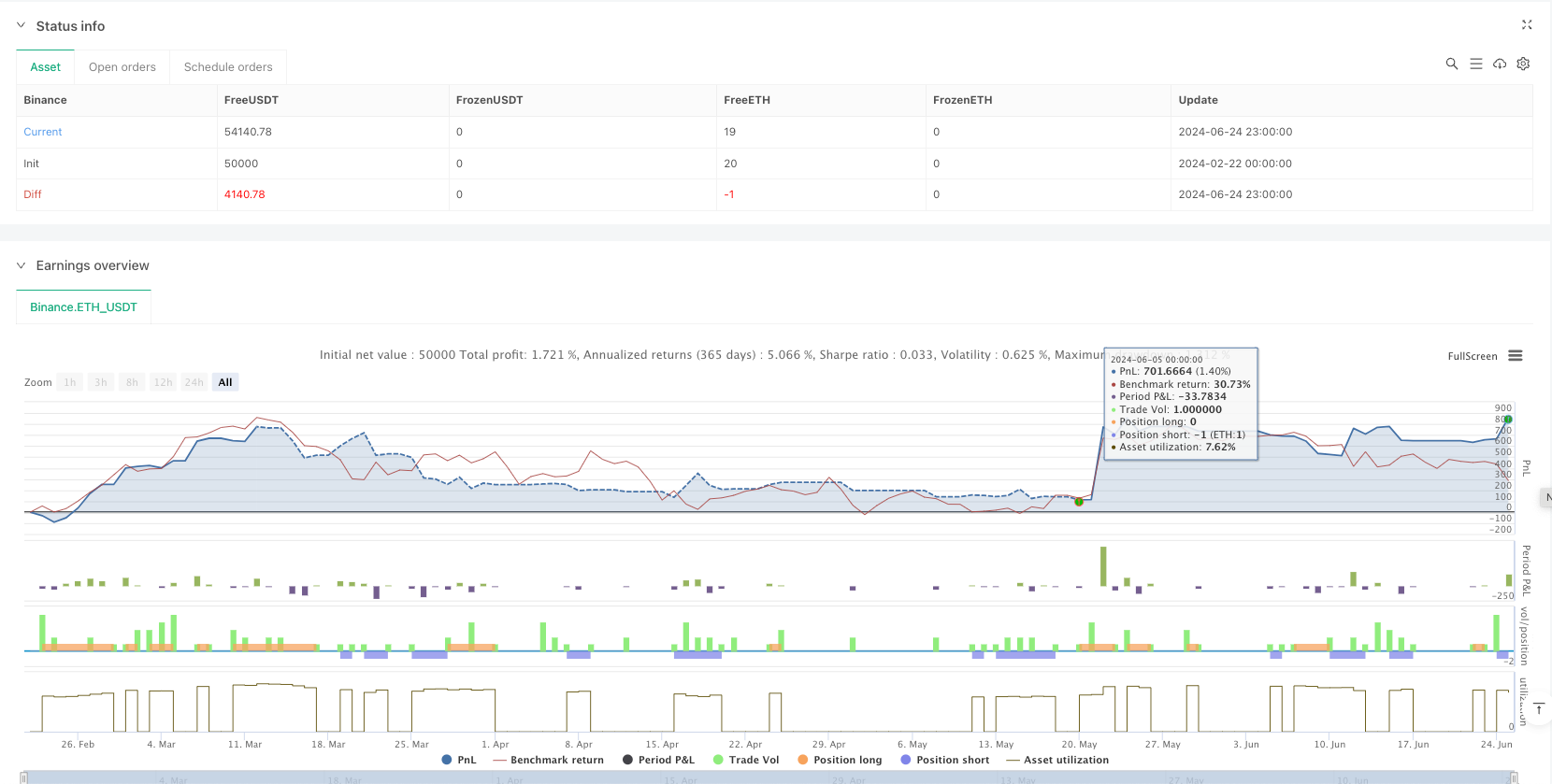

概述
该策略是一个基于多层移动平均线(SMA)的趋势跟踪系统,结合了精确的分笔交叉检测技术。它通过20、50、100和200周期移动平均线的层级关系来确定市场趋势,并使用实时价格与移动平均线的交叉来触发交易信号。策略设计充分考虑了不同时区和交易时段的普适性,能够在各种时间周期的图表上运行。
策略原理
策略采用三层趋势过滤机制,要求50周期均线位于100周期均线之上,且100周期均线位于200周期均线之上才确认上升趋势,反之则确认下降趋势。入场信号基于价格与50周期均线的交叉,使用分笔数据实现精确的交叉检测,通过比较当前价格行为与前一根K线的位置关系来确定交叉发生的时机。出场信号则由价格与20周期均线的关系决定,当价格突破20周期均线时触发平仓信号。
策略优势
- 精确的交叉检测机制提高了交易时机的准确性
- 多层移动平均线的趋势确认方式能够有效过滤虚假信号
- 策略具有良好的时区适应性,可以在全球任何市场使用
- 入场和出场逻辑统一且清晰,便于理解和执行
- 可以适用于多个时间周期的图表,具有较强的普适性
策略风险
- 在震荡市场中可能产生频繁的假信号,导致过度交易
- 移动平均线本身具有滞后性,可能错过重要的转折点
- 在快速波动的市场中,分笔交叉检测可能产生过多信号
- 多层趋势过滤可能导致错过一些潜在的交易机会
- 固定的出场条件可能在剧烈波动时导致较大回撤
策略优化方向
- 引入波动率指标来动态调整进出场条件,提高策略对市场环境的适应性
- 增加交易量确认机制,提高交叉信号的可靠性
- 设计动态的止损机制,更好地控制风险
- 加入市场结构分析,优化趋势判断的准确性
- 开发自适应的参数优化机制,提高策略的稳定性
总结
这是一个结构完整、逻辑清晰的趋势跟踪策略,通过多层移动平均线的配合使用,既保证了信号的可靠性,又实现了对趋势的有效跟踪。策略的设计充分考虑了实用性和普适性,适合在不同市场环境下使用。通过进一步优化和完善,该策略有望在实际交易中取得更好的表现。
策略源码
/*backtest
start: 2024-02-22 00:00:00
end: 2024-06-25 00:00:00
period: 1h
basePeriod: 1h
exchanges: [{"eid":"Binance","currency":"ETH_USDT"}]
*/
//@version=5
strategy("Multi-SMA Strategy - Core Signals", overlay=true)
// ———— Universal Inputs ———— //
int smaPeriod1 = input(20, "Fast SMA")
int smaPeriod2 = input(50, "Medium SMA")
bool useTickCross = input(true, "Use Tick-Precise Crosses")
// ———— Timezone-Neutral Calculations ———— //
sma20 = ta.sma(close, smaPeriod1)
sma50 = ta.sma(close, smaPeriod2)
sma100 = ta.sma(close, 100)
sma200 = ta.sma(close, 200)
// ———— Tick-Precise Cross Detection ———— //
golden_cross = useTickCross ?
(high >= sma50 and low[1] < sma50[1]) :
ta.crossover(sma20, sma50)
death_cross = useTickCross ?
(low <= sma50 and high[1] > sma50[1]) :
ta.crossunder(sma20, sma50)
// ———— Trend Filter ———— //
uptrend = sma50 > sma100 and sma100 > sma200
downtrend = sma50 < sma100 and sma100 < sma200
// ———— Entry Conditions ———— //
longCondition = golden_cross and uptrend
shortCondition = death_cross and downtrend
// ———— Exit Conditions ———— //
exitLong = ta.crossunder(low, sma20)
exitShort = ta.crossover(high, sma20)
// ———— Strategy Execution ———— //
strategy.entry("Long", strategy.long, when=longCondition)
strategy.entry("Short", strategy.short, when=shortCondition)
strategy.close("Long", when=exitLong)
strategy.close("Short", when=exitShort)
// ———— Clean Visualization ———— //
plot(sma20, "20 SMA", color.new(color.blue, 0))
plot(sma50, "50 SMA", color.new(color.red, 0))
plot(sma100, "100 SMA", color.new(#B000B0, 0), linewidth=2)
plot(sma200, "200 SMA", color.new(color.green, 0), linewidth=2)
// ———— Signal Markers ———— //
plotshape(longCondition, "Long Entry", shape.triangleup, location.belowbar, color.green, 0)
plotshape(shortCondition, "Short Entry", shape.triangledown, location.abovebar, color.red, 0)
plotshape(exitLong, "Long Exit", shape.xcross, location.abovebar, color.blue, 0)
plotshape(exitShort, "Short Exit", shape.xcross, location.belowbar, color.orange, 0)
相关推荐